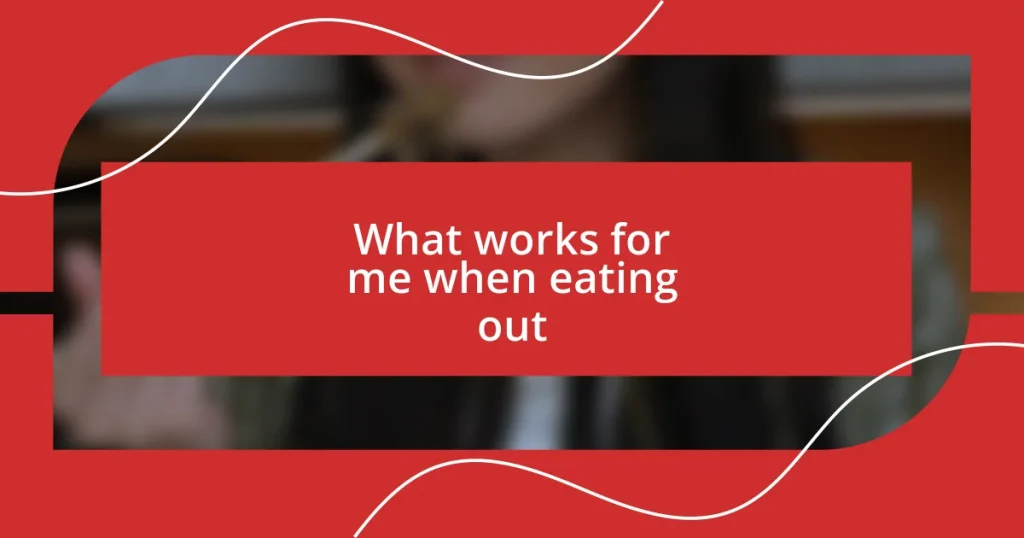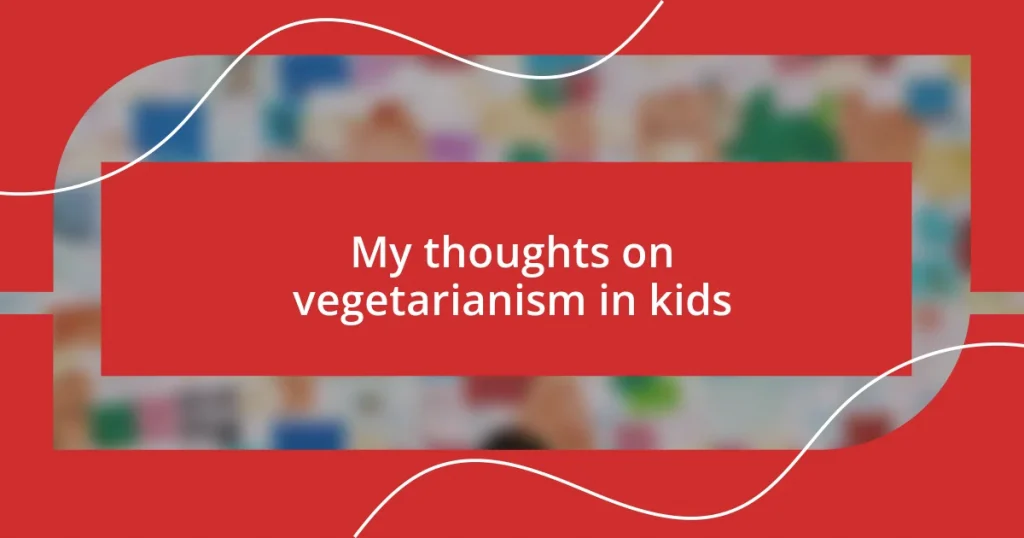Key takeaways:
- The author’s kitchen experimentation journey began with a spontaneous stir-fry pasta that sparked a passion for creativity in cooking.
- Ingredient substitutions and cooking techniques, such as toasting spices and layering flavors, greatly enhance dishes and lead to delightful surprises.
- Sharing culinary experiences, both successes and failures, fosters community and encourages growth in one’s cooking journey.

My kitchen experimentation journey
I still remember the first time I decided to veer off the recipe path. It was a rainy afternoon; I had just moved into my own apartment. With an urge to create something comforting, I tossed together whatever vegetables I had in the fridge with pasta and a splash of soy sauce. The result? A surprisingly delicious stir-fry pasta that sparked my passion for experimentation.
As I continued in the kitchen, I often found myself asking, “What if I added this spice?” My spice cabinet became a playground. One evening, I added cinnamon to a savory tomato sauce, and while it was a leap of faith, it transformed the dish, giving it a warmth that surprised my taste buds. Do you remember a time when you took a culinary risk that paid off? Those little victories always encouraged me to try more daring combinations.
Each experiment wasn’t just about the food; it was about the stories I created around them. I recall a particularly memorable dinner party where I experimented with a lavender-infused cheesecake. My friends’ intrigued faces as they tasted the unusual dessert inspired me deeply. There I was, blending flavors and memories, proving that cooking can be a genuine expression of creativity and joy.

Discovering new recipes
Discovering new recipes often feels like embarking on an adventure. I recall a rainy Sunday when I stumbled upon an old cookbook—a treasure I hadn’t looked at in years. Flipping through its pages, I found a recipe for a Moroccan tagine that called for ingredients I didn’t have. Instead of abandoning it, I replaced them with what I had on hand: chicken, carrots, and a hint of honey. The result was an aromatic dish that brought warmth to that dreary day, igniting my quest to redefine classic recipes with a personal twist.
- I let curiosity lead me to experiment, often blending cuisines, like adding a hint of coconut milk to my classic chili for a tropical flair.
- Social media became an inspiration hub for me; scrolling through pictures of vibrant dishes made me eager to recreate them, sometimes with my twist.
- Connecting with friends over “what’s cooking” conversations helped plant seeds for new ideas, turning my kitchen into a community hub.
- I learned that not every experiment turned out well, but even the failures were opportunities for laughter and learning, shaping my culinary journey.

The role of ingredient substitutions
The beauty of ingredient substitutions lies in their ability to transform a dish entirely. I remember one night, running late for dinner but eager to whip up something flavorful. The recipe called for garlic, but I realized I had none. Instead, I grabbed some shallots, and the gentle sweetness they imparted not only saved the meal but added an unexpected depth to my stir-fry. It became a delightful new favorite, reminding me that sometimes the best outcomes come from a little improvisation.
Thinking outside the box with substitutions can unlock new flavors and textures. For instance, I once had a craving for pancakes but found I was out of flour. Instead, I used almond meal, which resulted in a nutty, dense pancake that surprised everyone at breakfast. These moments are filled with joy and excitement as you rediscover familiar dishes from a different angle. They show how a simple swap can lead to exhilarating culinary experiences.
Part of the thrill in ingredient substitutions comes from the element of surprise. During one casual dinner, I wanted to make a quick sauce but had no soy sauce. I remembered my pantry stocked with balsamic vinegar instead. Drizzling it into the pan, I created a tangy sauce that married surprisingly well with grilled chicken. Sharing that moment with friends, witnessing their curiosity and enjoyment, reminded me just how impactful a creative substitution can be. Each instance of improvisation adds a chapter to my kitchen story, intertwining flavors, memories, and laughter.
| Ingredient | Substitution |
|---|---|
| Garlic | Shallots |
| Flour | Almond Meal |
| Soy Sauce | Balsamic Vinegar |

Techniques that enhance flavors
Sometimes, it’s not just about what you add to a dish but how you add it. I remember a time when I decided to toast my spices before incorporating them into a curry. The aroma that filled my kitchen was intoxicating! That simple step enhanced the spices’ natural oils and flavors, transforming an average meal into something unforgettable. Can you imagine the difference between a dish sprinkled with raw spices and one infused with those scents and depths? It’s a game-changer!
Layering flavors by building them step by step is another technique I’ve come to cherish. For example, when making a tomato sauce, I start with sautéing onions and garlic in olive oil. As those flavors meld together, the addition of fresh herbs makes the sauce sing. On one occasion, I experimented with adding a splash of red wine, and wow, the result was a rich, complex sauce that elevated my pasta night. Have you had that experience where one small addition completely transforms your dish?
I can’t stress enough how essential the right timing is in cooking. The moment I discovered that adding a sprinkle of sea salt at the end of cooking brings out the flavors like nothing else, it was a revelation! One evening, I made a roasted vegetable medley. Just when I thought it was perfect, I finished it with a salt flurry and a drizzle of lemon juice. The sharpness and contrast made every bite pop. Imagine the joy of watching others savoring those flavors, their expressions lighting up; it’s those moments that motivate me to continue exploring. Don’t you think cooking is all about finding those magical touches?

Overcoming kitchen challenges
When I think about kitchen challenges, one that stands out is the occasional kitchen disaster. I vividly remember a time when I misread a recipe and added way too much salt to a soup. Panic ensued as I tasted the outcome—definitely not what I had in mind! Instead of tossing it out, I quickly grabbed some potatoes, hoping they would absorb the excess salt. To my surprise, the result was a heartier soup that I ended up loving even more than the original. Hasn’t it happened to you that what seems like a disaster can turn into something wonderful with a little creativity?
Another challenge I often face is the pressure of timing, especially when I’m hosting friends for dinner. I’ll never forget a gathering when my oven malfunctioned, and I had to improvise with a stovetop dish instead. I pulled together a vibrant vegetable stir-fry, throwing in whatever I could find in the fridge. Each sizzling sound sparked excitement as my guests hovered around the kitchen, curious about this new concoction. It became a talking point of the evening, proving that sometimes pressure can turn into inspiration. Have you ever had to adapt on the fly, and found joy in that spontaneity?
Finally, I’ve struggled with mastering certain cooking techniques that seem daunting at first. For instance, I was intimidated by the idea of making homemade pasta. After several attempts that ended with flat, doughy discs, I nearly gave up. But then I decided to take a class, and the instructor shared simple tricks that changed everything. The joy I felt when the dough finally transformed into delicate, fresh fettuccine was immense! It was a reminder that overcoming challenges in the kitchen isn’t just about cooking; it’s about the journey and growth we experience along the way. Isn’t that what makes culinary adventures worthwhile?

Documenting the cooking process
Keeping track of my cooking experiments has become a delightful habit for me. I often jot down notes about ingredient substitutions, cooking times, and even the unexpected moments that lead to inspiration. Once, while attempting a new Thai dish, I realized halfway through that I had run out of coconut milk. Instead of panicking, I used almond milk instead. To my astonishment, the result was a creamy sauce with a nutty twist! Documenting that experience not only helped me remember what I did but gave me the confidence to be bold in future cooking adventures. Have you ever uncovered a surprising combination that you wished you’d noted?
I also love taking pictures during my cooking journey. It’s not just about sharing on social media; it’s about capturing the stages of the meal and the joy that unfolds. I remember snapping a photo of my colorful vegetable prep before tossing them into the pan. That moment of vibrant chaos reminded me just how much I enjoy the process. Those photos create a rich narrative of my experiences, allowing me to look back and see how my style and skills have evolved over time. Isn’t it interesting how visuals can evoke those cherished memories and keep us motivated?
Reflecting on my cooking notes and photos has revealed patterns in my culinary choices. For example, I often gravitate toward comforting, family recipes with a twist. One year, I documented my attempt at reimagining my grandmother’s famous chocolate chip cookies by adding sea salt and a sprinkle of espresso powder. The result? A subtle depth of flavor that took those beloved cookies to the next level. It was an exciting reminder that our culinary journeys are ongoing adventures, each dish a stepping stone toward even more creativity. How do you keep track of your culinary explorations?

Sharing results and feedback
Sharing my results with friends after a successful cooking experiment is one of my favorite parts of the process. Recently, I decided to whip up a batch of homemade pickles. I was nervous about how they would turn out, but when I shared them with a few friends, the delight on their faces made all the effort worthwhile. One friend even asked for the recipe—and that moment of connection through food felt incredibly rewarding. Have you ever seen someone light up over a dish you created? It’s a beautiful reminder of the power of sharing.
Feedback can be a double-edged sword. I remember a time when I tried a daring dessert with lavender and honey. It was a bold experiment, and while I adored the flavor profile, a couple of my friends found it too unusual. Initially, I felt a twinge of disappointment, but then I realized that their honest feedback opened up a new dialogue about tastes and preferences. This exchange not only made me reconsider my approach but also encouraged me to explore flavors further. Do you find feedback helps shape your culinary style, too?
I’ve found that sharing not just the successes but also the flops fosters a genuine sense of community in my kitchen. The last time a dish went south, I documented the whole ordeal, complete with my commentary and laughter over the experience. I shared it on social media, expecting a few chuckles, but it turned into an engaging thread where others shared similar tales of kitchen chaos. This connection through failures created a sense of solidarity and made me appreciate my culinary journey even more. Doesn’t it feel good to know you’re not alone in your kitchen mishaps?















